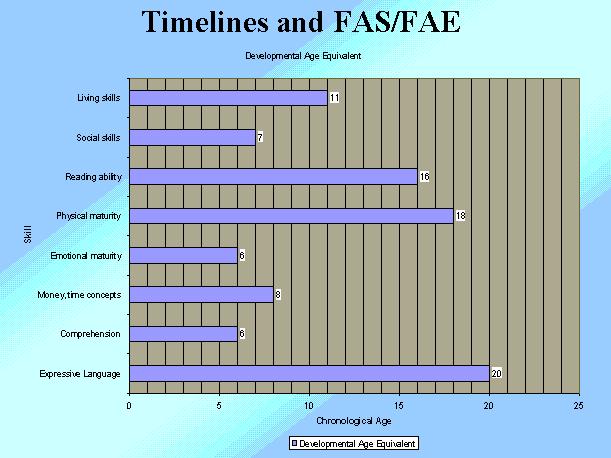
Chart adapted from http://www.come-over.to/FAS/timeline.htm
Functional assessment has occupied a cardinal role in the field of vocational rehabilitation for many years, and plays a central role in the daily work of rehabilitation professionals (Livneh & Male, 1993). Before looking at specific functional limitations, however, it is important to consider the words we use.
When describing functional limitations, loaded words should be avoided. For example, consider the word "lazy." This is a loaded word because it implies things about the person that may not be true, especially if the person has memory problems, or is depressed. Or consider the word "uncaring." If the person has trouble linking words with feelings, it may seem as if they don't care. Or consider the word "irresponsible," which can arise from a disparity between the person's chronological age and their functional age. For a more comprehensive list of loaded words that can promote misunderstanding, see http://www.come-over.to/FAS/cantwont.htm.
FUNCTIONAL LIMITATIONS
Important functional limitations may be hidden from view, and may not be obvious on first presentation. People with FAS/FAE may present a complex portrait of competencies and delays. It is not uncommon to encounter a mix of abilities and lags in any one person. The profile of maturation and strengths varies significantly between people with FAS and ARND. Chart 1 is intended to provide a visual cue for gaps that may be masked by abilities (for example, emotional immaturity may be hidden by strong expressive language skills.) According to Diane Malbin, the actual age of the individual was 18. In this case, Expressive language (bottom bar), and physical maturity (middle) may give one a first impression of normal development. It is only later that one might find out that social skills, emotional maturity, and comprehension are at the 6 - 7 year old level.
Chart 1. Timelines and FAS/FAE

It is when the expectation that a person is "on time" when they are actually developmentally much younger that conflict develops. "Why don't you act your age!" and "Grow up" are common comments which reflect frustration where immaturity has not been recognized as part of a normal variability in development. One parent said her feeling about her child changed after she was reminded to "Think younger." A gradual catch up is noted in young adults with FAS/FAE. Rather than being able to leave home at 18, a more realistic timeline may be 25 to 30. Ask yourself what responsibilities would be reasonable to expect from a 10 year old when confronted by a tall, verbal 16 year old with FAS or ARND. Adjust expectations accordingly. (Adapted from: Research findings of Streissguth, Clarren et al. by Diane Malbin 1994) (http://www.come-over.to/FAS/timeline.htm)
Livneh & Male (1993) have suggested that all functional limitations fall into one of six "realms", and the following list shows the correspondence between those realms and the kinds of functional limitations often observed in persons with FAS.
a) Physical-Structural limitations are the result of body parts that are missing, deformed or damaged. Some individuals with alcohol-related birth defects (ARBD), such as heart abnormalities, may have this type of limitation.Adaptive Behaviorb) Physical-Neurological limitations are those affecting mobility, manipulation, speech, and hearing, seeing, and other sensory functioning.
c) Cognitive Processing limitations are due to brain dysfunction, and include Mental Retardation and substance abuse. This category of functional limitations is quite common in persons with FAS.
d) Cognitive-Affective limitations relate to judgment, decision-making, motivation, concentration, and staying on task are also quite common in persons with FAS. Impulsivity is one indicator of this type of limitation.
e) Social Structural limitations include impaired ability to communicate through normal channels (e.g., speech impairment).
f) Social Affective limitations include difficulty forming or maintaining meaningful, rewarding or safe interpersonal relationships. This also is quite common among persons with FAS, and can present problems in the workplace.
One way to measure functional limitations is by means of an Adaptive Behavior assessment. As the Timelines chart illustrates, normal development in one area does not imply normal development in other areas. Adaptive behavior assessments are a very important tool to help us detect hidden areas of disability that might compromise, if undetected, the success of employment.
For example, here is a summary of Matthew B.'s Vineland (click here), assessed at the age of 19. This shows that in Communication and Daily Living skills, he was 5 - 7 years behind, and that in terms of socialization skills, he was functioning at less than half his chronological age. This demonstrates a significant functional limitation in the "Social-Affective" realm.
Vocational assessment and planning: Transition from School to Work
If possible, this process should begin in high school as part of transition planning, under the guidance of the IEP Team, and with the participation of the person with FAS. The "vocational assistant" on Michael B.'s IEP team made a big difference!